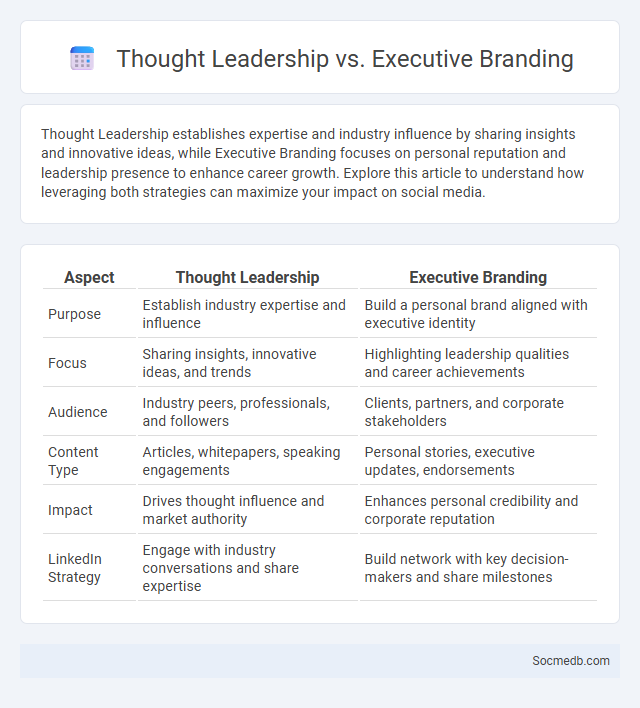
Photo illustration: Thought Leadership vs Executive Branding
Thought Leadership establishes expertise and industry influence by sharing insights and innovative ideas, while Executive Branding focuses on personal reputation and leadership presence to enhance career growth. Explore this article to understand how leveraging both strategies can maximize your impact on social media.
Table of Comparison
| Aspect | Thought Leadership | Executive Branding |
|---|---|---|
| Purpose | Establish industry expertise and influence | Build a personal brand aligned with executive identity |
| Focus | Sharing insights, innovative ideas, and trends | Highlighting leadership qualities and career achievements |
| Audience | Industry peers, professionals, and followers | Clients, partners, and corporate stakeholders |
| Content Type | Articles, whitepapers, speaking engagements | Personal stories, executive updates, endorsements |
| Impact | Drives thought influence and market authority | Enhances personal credibility and corporate reputation |
| LinkedIn Strategy | Engage with industry conversations and share expertise | Build network with key decision-makers and share milestones |
Understanding Thought Leadership: Definition and Key Elements
Thought leadership involves establishing your authority and expertise within a specific industry or niche, positioning yourself as a trusted source of innovative ideas and insights. Key elements include creating valuable, original content that addresses your audience's pain points, engaging authentically with followers, and consistently demonstrating deep knowledge and visionary thinking. Building a strong personal brand on social media requires strategic communication that highlights your unique perspectives and fosters meaningful connections with your community.
Executive Branding: What Sets It Apart?
Executive branding distinguishes itself on social media by showcasing a leader's unique expertise, vision, and influence, creating a personal narrative that resonates with target audiences. It leverages authentic storytelling and strategic content to build credibility, foster professional relationships, and amplify a leader's presence within their industry. This focused approach transforms personal profiles into powerful platforms for thought leadership and business growth.
The Core Differences Between Thought Leadership and Executive Branding
Thought leadership centers on sharing innovative ideas and expert insights to influence industry trends, while executive branding focuses on shaping a personal image that reflects leadership qualities and company values. Social media strategies for thought leadership emphasize content creation, like articles and webinars, that demonstrate expertise and foster trust among peers. Executive branding leverages platforms for showcasing personal achievements and leadership style, enhancing reputation and professional networks.
Overlapping Areas: Where Thought Leadership and Executive Branding Converge
Thought leadership and executive branding converge in social media through the strategic sharing of expertise and personal insights by business leaders, enhancing both individual credibility and corporate reputation. This overlapping area leverages platforms like LinkedIn and Twitter to foster authentic engagement, amplify professional influence, and drive business growth. Effective integration of thought leadership content with executive branding tactics results in a compelling digital presence that resonates with target audiences and industry peers.
Strategic Benefits of Thought Leadership for Business Growth
Thought leadership on social media enhances your brand's credibility, attracting a loyal audience and opening doors to new business opportunities. Leveraging thought leadership positions your business as an industry authority, increasing trust and driving higher engagement rates. Establishing your expertise through consistent, valuable content fosters stronger customer relationships and accelerates sustainable growth.
Enhancing Corporate Reputation Through Executive Branding
Executive branding on social media platforms significantly enhances corporate reputation by showcasing leadership's expertise, values, and vision. Consistent and authentic executive presence builds trust among stakeholders, strengthens brand credibility, and attracts potential investors and clients. Leveraging LinkedIn, Twitter, and professional blogs, executives amplify corporate messages, driving positive public perception and competitive advantage.
Metrics for Measuring Thought Leadership and Executive Branding Success
Key metrics for measuring thought leadership and executive branding success on social media include engagement rates, follower growth, and content reach, which indicate audience interaction and expanding influence. Tracking share of voice and sentiment analysis provides insights into brand reputation and perception compared to competitors. Monitoring backlinks and mentions helps assess the impact on online authority and demonstrates thought leadership in relevant industry conversations.
Case Studies: Leaders Excelling in Both Thought Leadership and Executive Branding
Leaders such as Satya Nadella and Sheryl Sandberg exemplify excellence in both thought leadership and executive branding on social media, leveraging platforms like LinkedIn and Twitter to share insights and foster engagement. Case studies reveal that strategic content focused on industry trends and authentic personal narratives significantly enhance their professional influence and corporate reputation. Data from LinkedIn Analytics indicates a 40% increase in follower engagement for executives who consistently combine thought leadership with personal branding efforts.
Common Misconceptions About Thought Leadership and Executive Branding
Many believe that thought leadership requires constant public visibility, but true influence comes from consistently delivering valuable insights and authentic expertise. Executive branding is often mistaken for personal promotion, yet it fundamentally builds trust by aligning leadership qualities with company values. Misconceptions overlook that effective thought leadership and executive branding drive meaningful engagement, not just social media presence.
Crafting a Winning Strategy: Integrating Thought Leadership with Executive Branding
Crafting a winning social media strategy requires integrating thought leadership with executive branding to amplify influence and credibility. Leveraging platforms like LinkedIn and Twitter, executives can share industry insights and innovative perspectives that resonate with target audiences. Consistent, authentic content tailored to showcase expertise strengthens brand authority and drives meaningful engagement.
 socmedb.com
socmedb.com